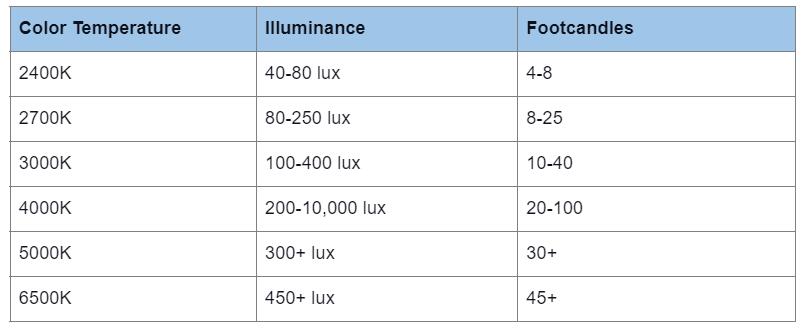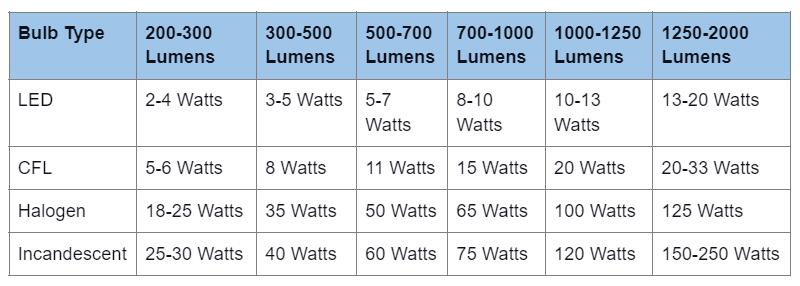When buying lighting fixtures for your home, workspace, or project, consider more than just the aesthetics. There are two key factors to check when selecting bulbs (especially LEDs). These have to do with lumens vs. Kelvin. We have looked at these two light quantity and quality measurement units in detail below, plus how they stack up against watts and illuminance. Read on to learn more!
Lumen vs. Kelvin: What is Lumen?
A lumen is a unit of measurement that denotes a bulb’s brightness level. With traditional bulbs, if you wanted a brighter one, you would get one with a higher wattage rating. However, this yardstick measurement became irrelevant with the introduction of LED bulbs.

Lumen vs. Flux
Why? LED lamps are energy efficient and can produce more brightness for the same wattage as a traditional bulb. For instance, a 15-watt LED bulb and a 100-watt incandescent bulb churn out the same output (about 1600 lumens).

LED lamp vs. incandescent lamp
Therefore, lumens became a more accurate brightness measurement unit because they indicate the actual light output of the bulb. On the other hand, watts define how much energy a bulb consumes.
What is Kelvin Temperature?
Denoted by the absolute temperature unit (K), Kelvin is the thermodynamic temperature SI base unit equal in magnitude to °C. The unit measures a light bulb’s color temperature, and the higher the measurement, the whiter and bluish the light.

The output of each specific kelvin temperature lamp
Color Temperature Chart
Cool temperature light sources (white/bluish lights) are very bright and can be harsh on home interiors. Therefore, you should consider using a temperature color scale to identify the right hue for your application.

A color temperature scale
Bulbs with a color temperature below 3500K are ideal for household use, while those above 3500K are suitable for hospital and industrial use.
Lumen vs. Kelvin: Color Temperatures of Light Bulbs
The temperature scale can help determine which bulb to use in each room. Consider the following light range, whether you need ambient or focused-task lighting.
- 2000K and below: Ideal for ambient illumination in low-light areas because such bulbs produce a dim glow, similar to candlelight.
- 2000K-3000K: A yellow to soft-white light ideal for bedrooms, dining rooms, and living rooms.
- 3000K-4500K: Gives off a bright white light, perfect for workspaces/offices, kitchens, and vanities.
- 4500K-6500K: Bright blue-white light similar to the bluish daylight cast. It is ideal for workspaces and display areas.
- 6500K and above: Cool, blue-toned lights ideal for bright task lighting in commercial applications.
Lumen vs. Kelvin: What About Watts?
As stated earlier, watts define how much power an electronic device consumes. Therefore, the higher the wattage, the more power the device consumes.
In technical terms, a watt is the power SI unit equivalent to one joule/second. This unit corresponds to the power flowing in an electrical circuit where the current is one ampere, and the potential difference is one volt.
Initially, a watt was the unit for measuring a bulb’s brightness. However, LEDs came about, and one advantage they had was being more energy efficient than incandescent and halogen bulbs while producing more light. Besides that, cool color temperatures seem brighter than those in the warmer range.

A halogen vs. LED bulb
Therefore, understanding the lumen output and Kelvin rating gives a better understanding of a bulb’s brightness than watts.
Lux vs. Kelvin
Besides lumen and Kelvin units for bulbs, a third light measurement unit exists named lux. Here’s how it compares with color temperature.
Difference Between Illuminance and Color Temperature
From the lighting-science technical perspective, lumen and lux describe the light quantity, while Kelvin describes the light quality. Illuminance falls into the quantity category, with its measurement unit being lux.
Illuminance defines how much light falls onto particular surfaces. It is a vital factor because the light bouncing off objects determines whether the brightness level is enough for activities like cooking, reading, drawing, etc.

A lux meter
This unit is different from a bulb’s lumen rating, which directly measures the brightness output. However, you measure lux at specific points, such as on walls, counters, or table tops. The lumen output is usually constant, but illuminance can vary based on the distance from the light source, room dimensions, bulb orientation, etc.
On the other hand, the color temperature falls into the quality category. Generally, warmer color temperatures have a rating of 2700K and below, while cooler color temperatures have a rating of 4000K going upwards.

A color temperature scale visualized by spotlights
Higher or cooler color temperatures appear brighter than those in the warmer range with the same lumen output. There is a relationship between brightness and color temperature in the form of a dimming curve, especially with incandescent bulbs. If you dim the bulb, its color temperature drops gradually.
Relationship Between Illuminance and Color Temperature
Empirical and theoretical research shows that people find low brightness environments more pleasing under warm color temperatures. Similarly, the study suggests we generally find high brightness environments pleasing under cool color temperatures. Christened the Kruithof curve, this relationship got its name from Arie Anders Kruithof, the Dutch physicist who studied this phenomenon.
Therefore, when planning to fix cool color temperature lighting fixtures in a particular space, ensure the area has sufficient brightness. If not, the lighting will appear unnatural and unpleasant.
For instance, a 200 lux illuminance level (20 footcandles) is sufficient for a lighting installation with a color temperature of about 3000K. Higher color temperature fixtures (above 3000K) will make objects appear dull and unpleasant for the same illuminance level.

A lux meter is used to check the light condition for plant growth
Similarly, installing a fixture with a color temperature lower than 3000K will make objects appear unnaturally red.
Minimum Illuminance Levels Recommended for Each Color Temperature
It is necessary to pick the best color temperature for specific illuminance levels. The following table gives a rough estimate of how to match the two variables.

However, your personal preferences might be different.
Lumen vs. Kelvin vs. Watts: Why Buy Based On Lumens?
In a nutshell, a lumen is the indicator of brightness, Kelvin defines the light color, and watts show how much energy the bulb consumes. Most people primarily buy light bulbs based on their luminance.
Therefore, the lumen value is more important. After estimating the required brightness, the second step is determining the light quality, where the color temperature comes in.
As stated earlier, Watts was the best brightness indicator before the development of LEDs, and here’s how it compares with lumens.

Incandescent, LED, and energy-saving light bulbs.

It is possible to convert watts to lumens or lumens to watts using these respective calculators.
Summary
In conclusion, brightness and color temperature are critical factors for bulb selection (especially LEDs.) It is also vital to pick the right color temperature that matches the illuminance of indoor spaces. We hope this article has been insightful and if you think we missed something, drop a message to let us know what you think.
